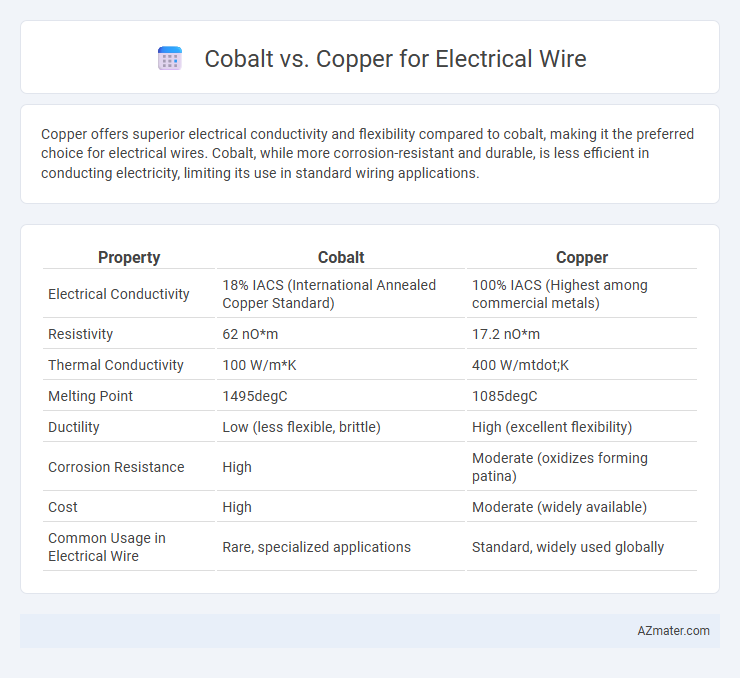Copper offers superior electrical conductivity and flexibility compared to cobalt, making it the preferred choice for electrical wires. Cobalt, while more corrosion-resistant and durable, is less efficient in conducting electricity, limiting its use in standard wiring applications.
Table of Comparison
| Property | Cobalt | Copper |
|---|---|---|
| Electrical Conductivity | 18% IACS (International Annealed Copper Standard) | 100% IACS (Highest among commercial metals) |
| Resistivity | 62 nO*m | 17.2 nO*m |
| Thermal Conductivity | 100 W/m*K | 400 W/mtdot;K |
| Melting Point | 1495degC | 1085degC |
| Ductility | Low (less flexible, brittle) | High (excellent flexibility) |
| Corrosion Resistance | High | Moderate (oxidizes forming patina) |
| Cost | High | Moderate (widely available) |
| Common Usage in Electrical Wire | Rare, specialized applications | Standard, widely used globally |
Introduction to Electrical Wire Materials
Electrical wire materials primarily consist of copper and aluminum due to their excellent electrical conductivity and flexibility, but cobalt is emerging as a niche alternative for specialized applications requiring higher corrosion resistance and thermal stability. Copper remains the industry standard for most electrical wiring because of its superior electrical conductivity (approximately 5.96 x 10^7 S/m) and ductility, which ensures efficient current flow and easy installation. Cobalt, with lower conductivity but enhanced mechanical strength and thermal tolerance, is beneficial in high-temperature environments or where durability under mechanical stress is critical.
Overview of Cobalt and Copper Properties
Cobalt exhibits high thermal stability, excellent corrosion resistance, and strong magnetic properties, making it suitable for specialized electrical applications requiring durability and reliability under extreme conditions. Copper offers superior electrical conductivity, excellent ductility, and cost-effectiveness, positioning it as the industry standard for general electrical wiring and power transmission. The choice between cobalt and copper hinges on balancing conductivity needs with mechanical strength and environmental resistance in specific electrical use cases.
Conductivity Comparison: Cobalt vs Copper
Copper exhibits significantly higher electrical conductivity than cobalt, making it the preferred material for electrical wiring due to its efficiency in transmitting electrical current with minimal resistance. Cobalt's conductivity is approximately 14% that of copper, which limits its practicality in applications requiring optimal electrical performance. Despite cobalt's superior strength and corrosion resistance, copper remains the industry standard for electrical conductors because of its excellent balance of conductivity and ductility.
Thermal Performance in Electrical Applications
Cobalt exhibits superior thermal conductivity compared to copper, making it highly efficient for heat dissipation in electrical wires. Its higher melting point allows cobalt-based conductors to maintain performance stability in high-temperature environments, reducing the risk of thermal degradation. Copper remains widely used due to its excellent electrical conductivity, but cobalt's thermal advantages provide critical benefits in specialized high-heat applications.
Durability and Corrosion Resistance
Cobalt offers superior durability and exceptional corrosion resistance compared to copper, making it ideal for electrical wires exposed to harsh environments. Copper, while highly conductive and widely used, is more prone to oxidation and corrosion over time, especially in moist or acidic conditions. The enhanced longevity of cobalt-based wiring reduces maintenance costs and ensures stable electrical performance in demanding applications.
Cost Analysis: Cobalt vs Copper Wire
Copper wire remains the industry standard for electrical wiring due to its lower cost per kilogram, averaging around $6-$9 compared to cobalt's significantly higher price, which can exceed $50 per kilogram. The cost efficiency of copper ensures broader accessibility and widespread use in residential and commercial electrical systems, while cobalt's expense restricts its application to specialized, high-performance areas such as aerospace or medical devices. Evaluating long-term investments, copper's affordability and excellent conductivity provide superior value in large-scale electrical installations over cobalt wire.
Availability and Supply Chain Factors
Copper remains the primary choice for electrical wire due to its widespread availability and well-established global supply chain, ensuring consistent access and stable pricing. Cobalt, while offering superior corrosion resistance and conductivity in niche applications, faces supply constraints concentrated in the Democratic Republic of Congo, posing risks related to geopolitical instability and ethical sourcing. The limited refining infrastructure and fluctuating cobalt demand contribute to supply chain volatility, making copper a more reliable material for standard electrical wiring projects.
Environmental Impact and Sustainability
Cobalt mining poses significant environmental challenges due to toxic byproducts and habitat disruption, whereas copper extraction generally has a lower ecological footprint with more established recycling programs. Copper's high recyclability reduces the need for new mining, promoting sustainability in electrical wiring applications. Sustainable practices in copper usage contribute to lower greenhouse gas emissions compared to cobalt, which remains critical but environmentally contentious in battery and wire production contexts.
Common Applications of Cobalt and Copper Wires
Copper wires dominate electrical wiring in residential, commercial, and industrial applications due to their excellent conductivity, flexibility, and affordability. Cobalt wires, though less common, are primarily used in specialized environments such as high-temperature heating elements, aerospace components, and magnetic applications, benefiting from cobalt's superior strength and corrosion resistance. Copper's widespread use in power transmission, telecommunications, and electronics contrasts with cobalt's niche role in high-stress, high-performance electrical systems.
Choosing the Right Material for Your Electrical Needs
Copper remains the preferred choice for electrical wire due to its superior electrical conductivity and cost-effectiveness compared to cobalt. While cobalt offers high strength and corrosion resistance, its lower conductivity and higher price make it less practical for standard electrical wiring applications. Selecting copper ensures optimal performance and efficiency in residential and commercial electrical systems.

Infographic: Cobalt vs Copper for Electrical Wire
 azmater.com
azmater.com